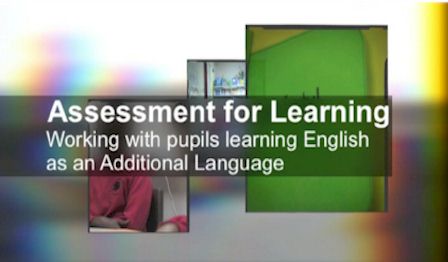
Introduction
This session is not intended to be an introduction to EAL. The materials assume that student teachers will already have had some input on issues related to bilingualism and second language acquisition and to the teaching and learning of EAL. The materials are intended to support teachers to understand how linguistic influences affect children's learning and how to how to make provision for EAL learners in order to meet the Professional Standards for the award of Qualified Teacher Status (TDA 2007) and the new Teachers' Standards. This session provides tutors, mentors and others involved in teacher training and education with suggestions for building student teachers’ professional attributes, skills and knowledge in assessment in order to work effectively to support the learning of bilingual pupils in their particular contexts.
It is suggested that the session would be most effective after student teachers had already had some experience of schools through their initial placements. The sessions are likely to fit well within Professional Studies in Year 3 or prior to the second placement in a PGCE. The resource is also suitable for flexible use by school-based mentors and colleagues involved in continuing professional development for both specialist and mainstream teachers of EAL learners.
Within the session, student teachers will consider a range of evidence, including video of classroom footage and interviews with teachers and a well known expert. The use of multimedia and source material allows all student teachers to benefit from the sessions, not only those who are training in a multilingual, ethnically diverse environment. The materials used within the session are intended to provide student teachers with some understanding of these issues even if their own placements are in largely monolingual schools. Materials cover primary contexts but tutors can adapt the session to suit the needs of their student teachers. A secondary module is in development. The materials include material suitable for pre and post session activities and suggestions for assessed tasks.
The suggested session involves student teachers in thinking about formative assessment, also known as assessment for learning, for EAL learners, that is pupils who are learning curriculum content and English language at the same time. For these pupils, the ability to engage in formative dialogue with teachers can not be assumed – particularly for those who are at early stages of learning English. For example, pupils learning EAL may not understand what is required of them, by teachers or in classroom activities and they may not be able to demonstrate their understanding and learning, orally or in writing. So teachers need to be able to assess pupils’ language learning and curriculum content learning holistically and separately. The video focusses on the types of practical learning activities which can support formative assessment of pupils who are learning English language and curriculum content at the same time. It looks particularly at spoken language in classroom interaction; for pupils learning EAL, oral language is a helpful basis for reading and writing development.
The materials can be used within a 2-3 hour session. The video which accompanies this module is about 30 minutes. Tutors interested in using the materials can obtain copies of the video by emailing ite@naldic.org.uk. Please note that as stocks of the DVDs have now been exhausted, there will be a charge for copying whilst we make arrangements to make the materials available online.
Pre-session readings:
Students should be encouraged to familiarise themselves with materials and information in the Assessment section of this website. For tutors and mentors, familiarisation with the Session Notes for Tutors is recommended as preparation for the session.
Contributing Authors
Nicola Davies
Constant Leung
Kimberly Safford
First published 7 June 2009
Resources
Resources to enable tutors and mentors to lead the session are downloadable to the right. Colleagues wishing to use the module can contact ite@naldic.org.uk to be sent a price for the DVD containing all the video and print resources.
Further reading
Assessment Reform Group (2002) Assessment for Learning: 10 Principles
Research-based Principles to Guide Classroom Practice
Black, P., Harrison, C., Lee, C., Marshall, B., & Wiliam, D. (2002). Working inside the black box. London: Dept of Education and Professional Studies, King's College London
Black, P., Harrison, C., Lee, C., Marshall, B., & Wiliam, D. (2003). Assessment for learning: putting it into practice. Maidenhead, Berkshire: Open University Press
Black, P., & Wiliam, D. (1998). Inside the black box. London: King's College London.
Leung, C. (2004). Developing Formative Teacher Assessment: Knowledge, Practice and Change. Language Assessment Quarterly, 1(1), 19-41.
Leung, C., & Mohan, B. (2004). Teacher formative assessment and talk in classroom contexts - assessment as discourse and assessment of discourse. Language Testing, 20(3), 335-359.